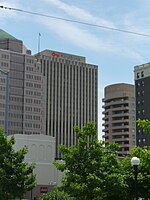Dayton ( ) is a city in and the county seat of Montgomery County, Ohio, United States. A small part of the city extends into Greene County. As of the 2020 census, the city proper had a population of 137,644, making it the sixth-most populous city in Ohio. Dayton anchors the state's fourth-largest metropolitan area, the Dayton metropolitan area, which had 814,049 residents. Dayton is located within Ohio's Miami Valley region, 50 miles (80 km) north of Cincinnati and 60 miles (97 km) west of Columbus. It is a principal city of the Dayton–Springfield–Sidney combined statistical area, home to a population of 1,086,512.Dayton was founded in 1796 along the Great Miami River and named after Jonathan Dayton, a Founding Father who owned a significant amount of land in the area. It grew in the 19th century as a canal town and was home to many patents and inventors, most notably the Wright brothers, who developed the first successful motor-operated airplane. It later developed an industrialized economy and was home to the Dayton Project, a branch of the larger Manhattan Project, to develop polonium triggers used in early atomic bombs. With the decline of heavy manufacturing in the late 20th century, Dayton's businesses have diversified into a service economy.
Ohio's borders are within 500 miles (800 km) of roughly 60 percent of the country's population and manufacturing infrastructure, making Dayton a logistics hub. The city is home to Wright-Patterson Air Force Base, a significant contributor to research and development in the industrial, aeronautical, and astronautical engineering fields. Along with defense and aerospace, healthcare accounts for much of the Dayton area's economy. Significant institutions in Dayton include the Air Force Institute of Technology, Carillon Historical Park, Dayton Art Institute, Dayton Performing Arts Alliance, National Museum of the United States Air Force, and University of Dayton.












